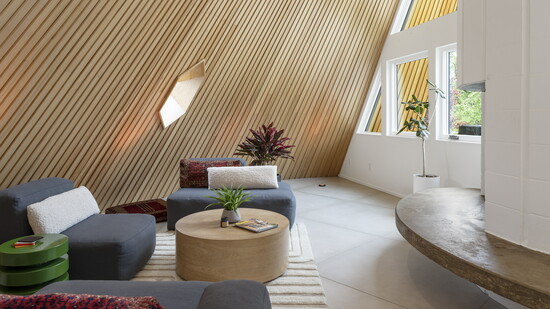When Charles Haertling first designed the Johnson House in 1976, the world was in the throes of an energy crisis, marked by significant oil shortages and price spikes. Ever the innovator, Haertling designed the home to incorporate the first wave of solar energy design, in the form of passive solar windows and an active solar thermal system.
Today, Haertling is remembered as an experimental architect, constantly pushing clients, banks, and even city code to design spaces focused around the experience—both in terms of the feeling of being within them and the power of gathering together.
His projects put most of the money into what he’d call the “public spaces.” He thought people should live primarily in their living rooms and saw bedrooms as secondary, especially by current standards.
“We’ve done a number of Haertling houses, and they’re always the same,” says Harvey Hine, Director of Architecture at HMH Architecture + Interiors. “Bedrooms are basement level with minimal windows, low ceilings, and usually a pretty small staircase.”
When approaching the Johnson Home renovation, HMH’s goal was clear: turn it into a family home more in line with modern standards, while maintaining the architectural integrity set forth by someone Hine saw as a friend and mentor.
To do this, the team expanded the basement, which they did not see as architectural to begin with, to improve the bedroom size and light.
Upstairs, they had to be much more careful. The original structure had two towers, one to house the stairwell and one for a significant fireplace. They added a third tower to create a distinct space for a powder bathroom off the entry.
They also opened up the loft for a home office and extended the circle of the home to create a dining space off the back of the kitchen.
To further bring it up to modern standards, they replaced all the windows and doors to be more energy efficient and switched out the wood paneling with a replica of the original after fixing significant leaks.
Bringing the interior spaces into better alignment with how families live today was the work of Leah Civiok, HMH’s Director of Interior Design. She reimagined the interior layout to improve flow, functionality, and livability—all while working within Haertling’s original vision.
“The owners loved the intention of the house and didn’t want to change it but make it better,” says Leah Civiok, Director of Interior Design. “Everybody on the team respected the existing architecture.”
As with any project of this scope, there were surprises along the way, and it required a team effort to problem-solve and ultimately create a better product. One of those partners was Isaac Savitz at Silver Lining Construction, whose first and likely biggest issue was the house’s lack of foundation.
“When you’re working on a remodel like this, you discover things, like no foundation, that you have to deal with,” says Hine. “There’s always surprises, and a lot of contractors prefer remodeling because of the extra detective work.”
When the homeowners encountered selection fatigue, they brought in designer Susan Hall for guidance. If you haven’t undergone a major build or renovation, it’s like curating an entirely new wardrobe—complete with all of the accessories, including jewelry—that you’re trying to keep within a finite budget.
Working with HMH and the owners to create a unique, original house of their very own within such a significant building was a dream project. She saw it as their duty to let the house be itself, but even better.
“It really is like a sculpture,” says Hall. “And good sculpture is worth preserving.”
This is the ultimate home for hosting, and the team made sure the new floors are dance party ready, ensuring people can gather around the hearth for generations to come.
